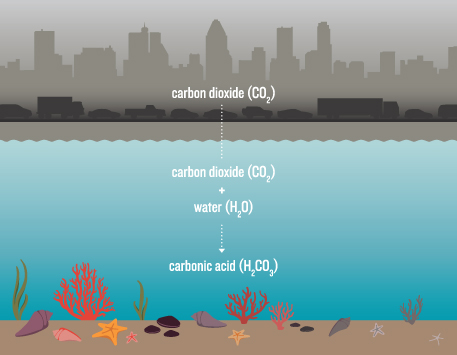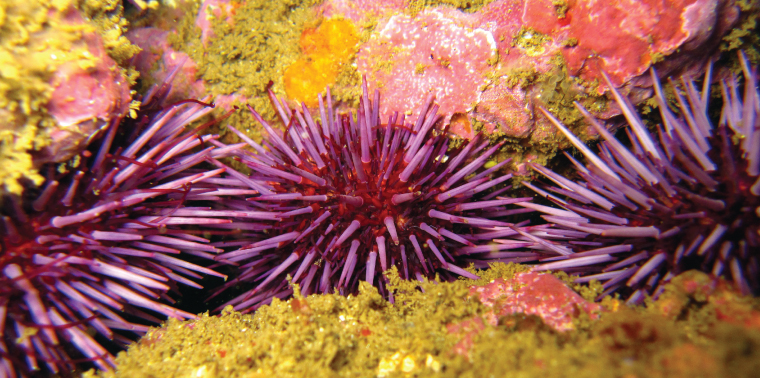February 7, 2013 — The sky is low and dusky, and the rain comes in blustery gusts as we make our way out onto a spill of rocks that juts seaward from the shore just north of Boiler Bay on the Oregon coast. Low tide is just beginning; at times it looks as if we’ll be swamped by waves. It’s October 30 and in the late afternoon gloaming, my eyes take a few minutes to adjust so I can begin to differentiate mussels from rock and to spot the clutch of seals watching our progress.
To the scientists who make up the Ocean Margin Ecosystem Group for Acidification Studies, this spot is known as the Fogarty Creek Intertidal Long-Term Ecological Research Site. The obvious drama of this place comes from the waves and wind and charismatic whiskered marine mammals. But I’m here to witness a different kind of drama with Oregon State University graduate student Jeremy Rose, who specializes in marine ecology and is part of a team of scientists investigating the effects of ocean acidification on the small organisms that inhabit the rocky tide-pool landscape beneath our feet.
Over the past 250 or so years, the acidity of the world’s oceans has increased 30 percent.
While it can’t be seen in a glance, what’s happening to the marine environment on the Pacific Northwest coast as a result of the growing concentration of carbon dioxide in Earth’s atmosphere is indeed dramatic. Since the mid-18th century, human activity—mainly fossil fuel burning—has increased the atmospheric concentration of CO2 by about 40 percent. Because oceans absorb about a quarter of the CO2 released into the atmosphere each year, as more CO2 enters the atmosphere, more ends up in the ocean. “Think of carbon as a global pollutant that affects the ocean everywhere it touches the sky,” explains Stanford University marine science professor and Hopkins Marine Station director Steve Palumbi.
As CO2 dissolves in seawater, chemical reactions produce an acid. Over the past 250 or so years, the acidity of the world’s oceans has increased 30 percent. Scientists believe oceans have not experienced the current level of acidity in about 2 million years. Not only that, but according to National Oceanic and Atmospheric Administration senior scientist Richard Feely, conditions are changing faster than anything seen in geologic history. If today’s global CO2 emission trends continue, scientists estimate that by the end of this century, oceans will be more acidic than they have been for more than 20 million years.

Carbon dioxide given off by vehicles, power plants and other human sources spells trouble for many marine organisms. The gas combines with seawater to form carbonic acid, which reduces availability of the carbonate ions they need to build shells and other structures. Acidification also appears to disrupt physiological processes. Illustration by Sarah Youngquist.
And that’s a problem. The rise in dissolved CO2 and concurrent drop in pH (lower pH indicates higher acidity), changes ocean chemistry in a way that robs marine organisms, such as mollusks and corals, of the carbonate ions they need to build shells and skeletons. At the same time, the increasing acidity can erode the structures they’ve already built, and appears capable of disrupting their bodies in other ways that make it hard for them to thrive. This is bad news not only for the organisms themselves, but also for people who rely on them for food and jobs, and perhaps even more profoundly, for the stability of the ecosystems with which they—and we—are intertwined.
Investigating Impacts
The chemistry behind ocean acidification is well understood. What scientists are working on now is trying to understand what is happening within marine organisms and their coastal communities as the ocean’s pH drops at the same time marine environments experience other stressors such as warming temperatures, pollution and overfishing.
Among their big questions: Can marine species adapt to this rapid change, and if so, how? Or as Morgan Kelly, a postdoctoral researcher studying ocean acidification impacts at the University of California, Santa Barbara, puts it, “Will evolution come to the rescue?”
Ensia shares solutions-focused stories free of charge through our online magazine and partner media. That means audiences around the world have ready access to stories that can — and do — help them shape a better future. If you value our work, please show your support today.
Yes, I'll support Ensia!
